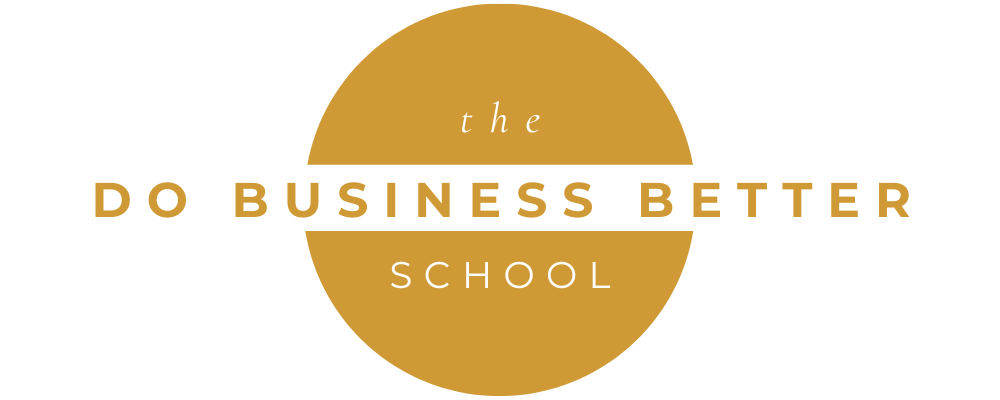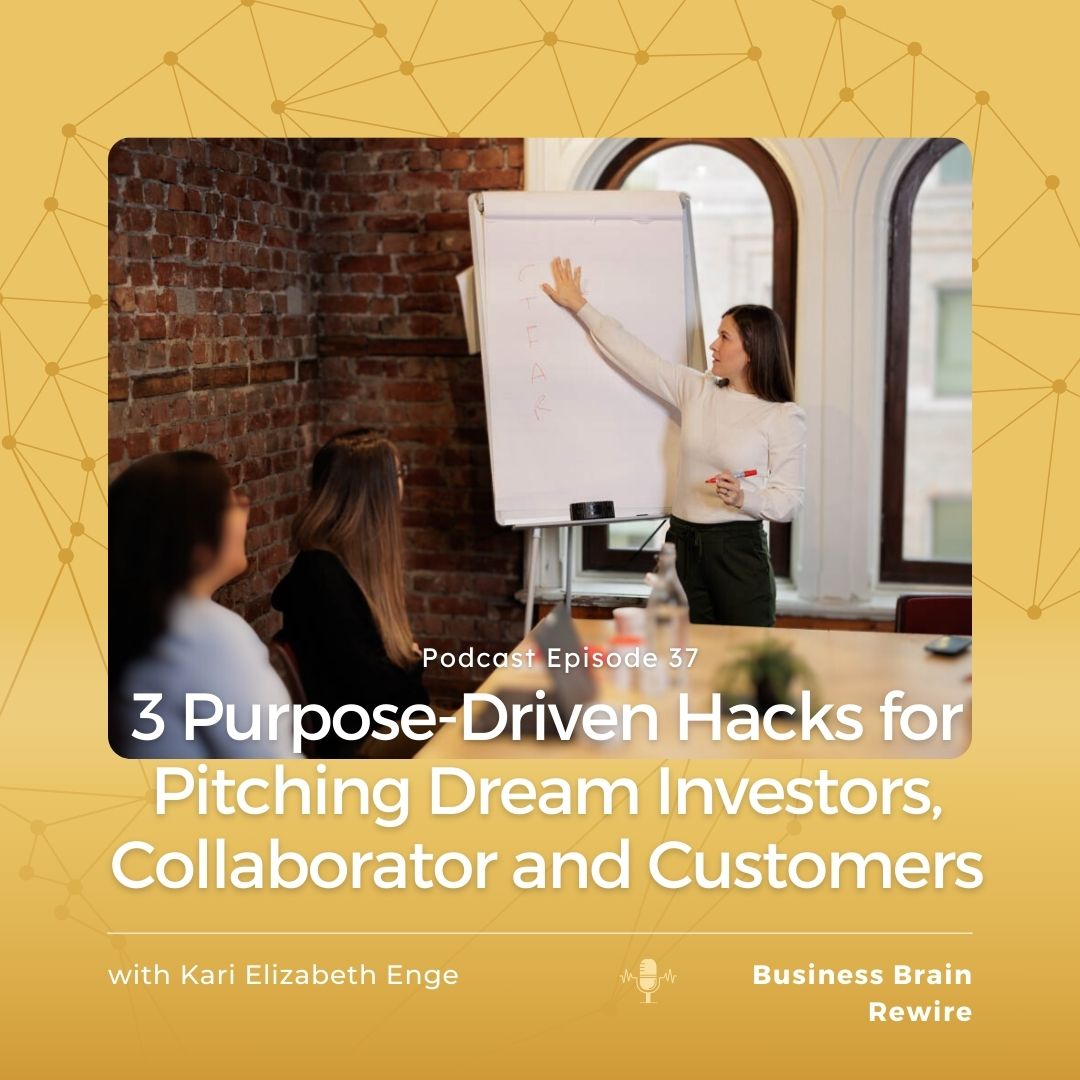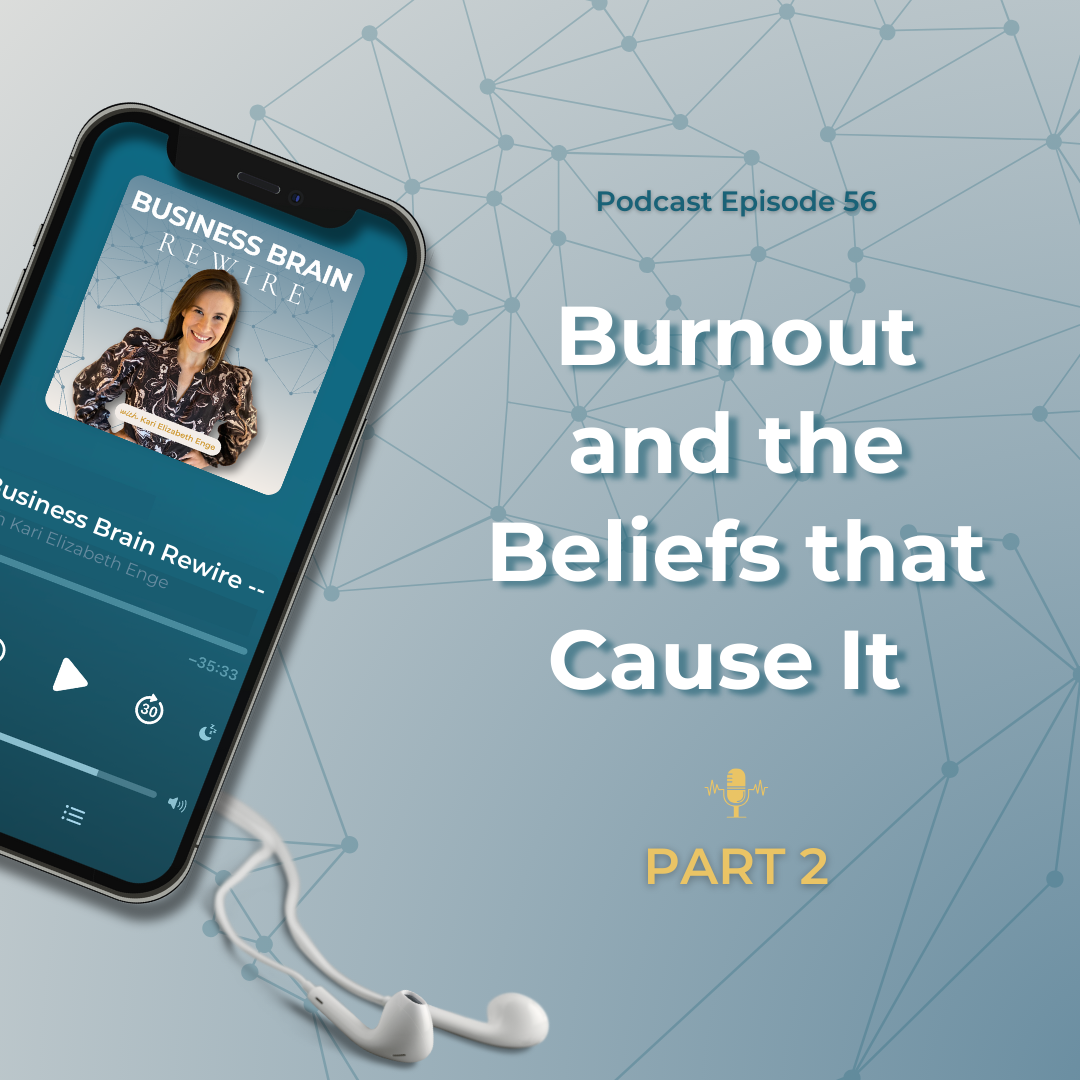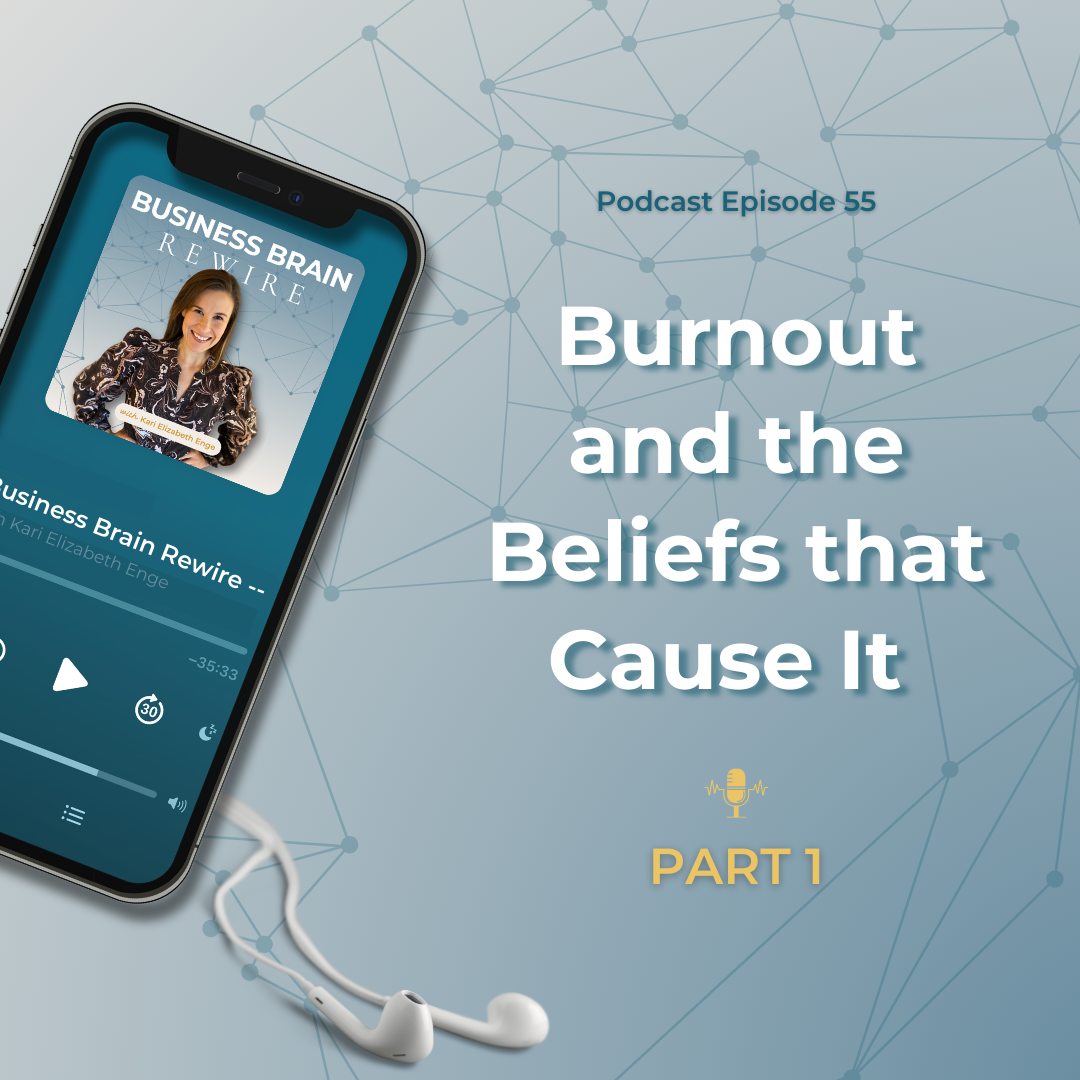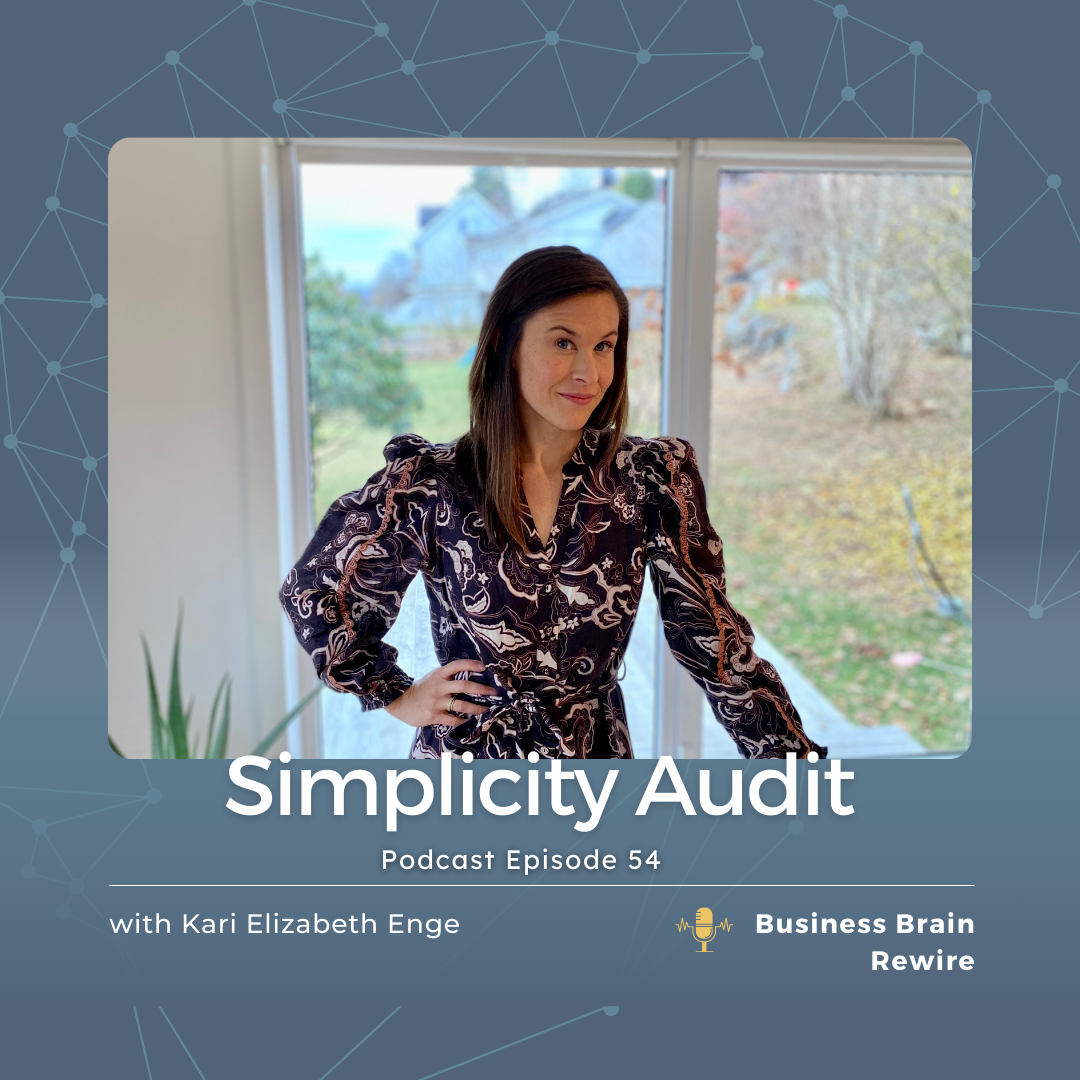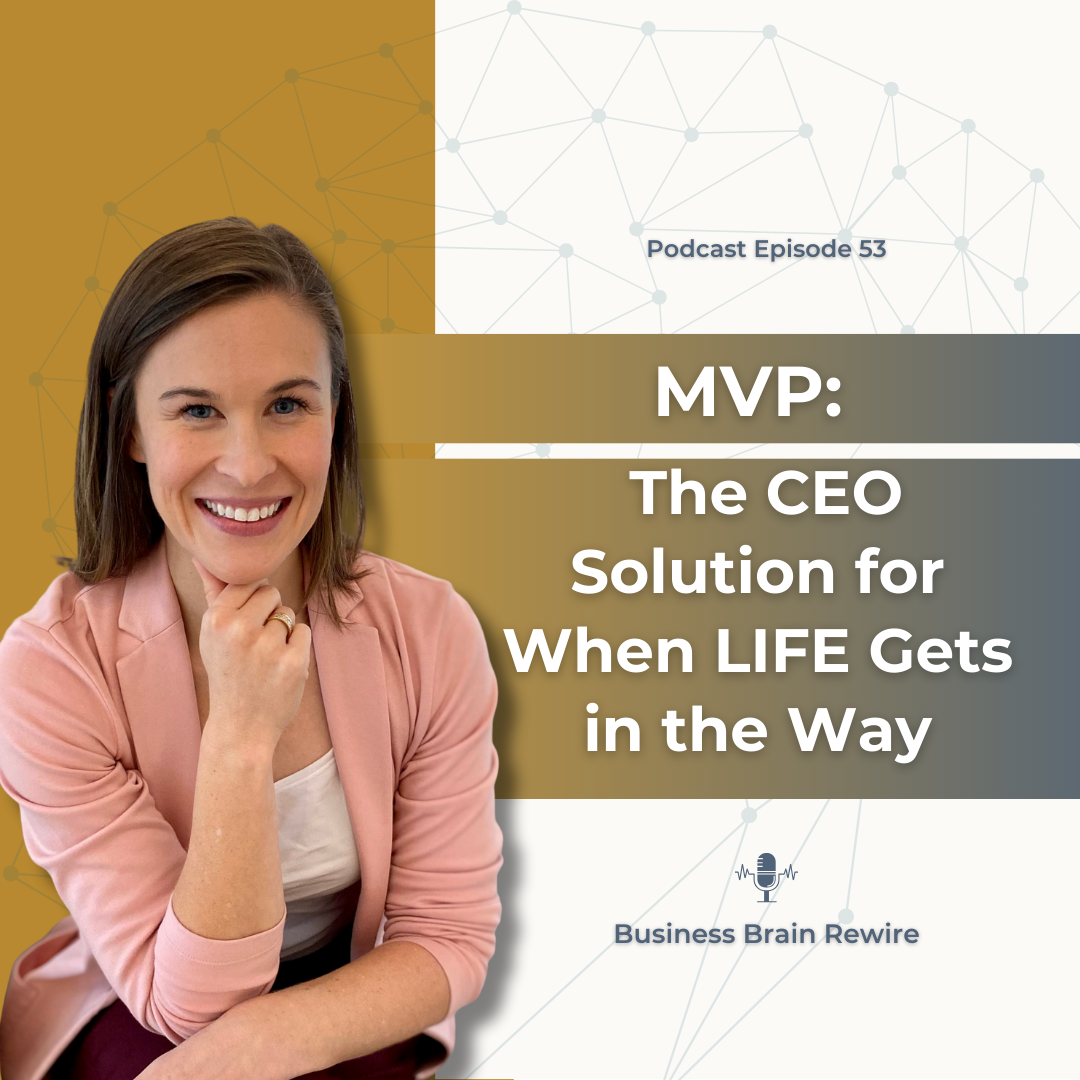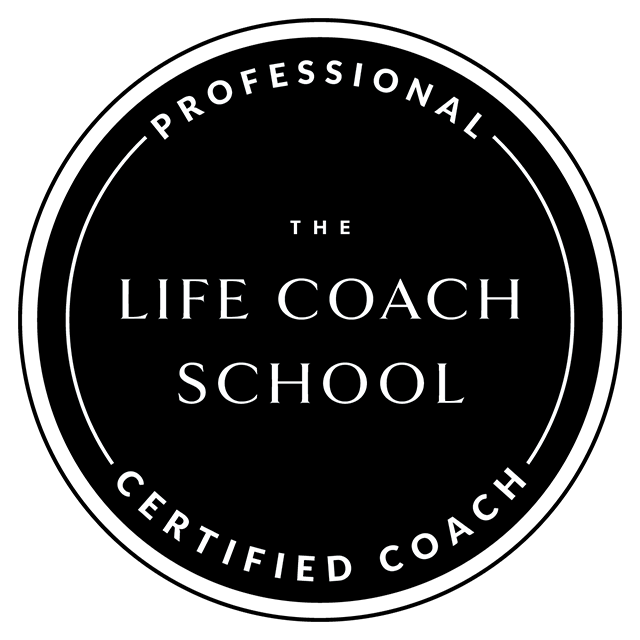If you’ve ever found yourself over-preparing for a big pitch, rehearsing every possible objection, or trying to “prove” your worth to an investor, collaborator, or customer—this episode is for you.
Most founders believe that a great pitch is about having the perfect words, the perfect deck, and the perfect strategy.
But what if the real key to landing your dream investor, closing that big customer, or securing the perfect collaboration has nothing to do with what you say—and everything to do with how your nervous system responds?
In this episode, I’m breaking down three unexpected yet powerful hacks that will change the way you approach pitching forever. You’ll learn why your brain is hardwired to sabotage your success in high-stakes conversations—and how to flip the script so you show up with confidence, ease, and connection.
I’ll share real-life stories from my own experience and from founders I’ve worked with—so you can see exactly how to shift your mindset, regulate your nervous system, and create emotional buy-in that leads to results. These purpose-driven strategies will help you attract the right people, build relationships that truly align with your mission, and amplify your impact.
Forget the high-pressure, fight-or-flight pitching culture that leaves you drained and frustrated. Instead, learn how to master the energy of collaboration and positive change, so the right investors, customers, and partners can’t wait to work with you.
Because when you pitch from a place of alignment, you don’t just grow your business—you create lasting change that serves the world.
In this episode, you’ll learn:
- The surprising neuroscience behind why most pitches fail before they even begin
- How to shift from a defensive, high-pressure stance into natural, effortless connection
- The #1 mindset shift that makes investors and customers want to buy into your vision
- A simple but game-changing way to prep for big meetings and presentations without over-rehearsing
If you’re ready to show up, sell, and serve the world with more confidence, clarity, and ease—hit play now.
Mentioned in today’s episode:
#1 If you loved this episode, then check out: Simply Sustainable.
You’ll learn a founder framework that helps you apply Lean Startup Principles in actual practice – so you move the needle faster with more ease. Plus, we add nervous system tools to the process (our secret sauce) so you are clear, confident, organized and growing your company while protecting your personal life and wellbeing.
Book a free consult call now, to see if it’s right for you and your company.
#2: Every Wednesday, I share a neuroscience-based strategy to grow your company that you won’t find anywhere else. Subscribe to get access to the systems you need for sustainable success.
Transcript:
[00:00:00] Hey founders, welcome to today’s show. Today I want to talk to you about my three biggest tips for pitching dream investors, collaborators, and customers. I’m going to give you some very specific examples from founders, from some accelerators that I have taught recently, as well as examples from recent times where I have pitched to a collaborator I really wanted to work with. There’s going to be a lot of very specific examples today, both from myself and other founders, in hopes that it will really help you to apply all of the tips that I’m, giving you. A lot of times we hear these things out in the world, in the business world of do this and do that and try this, but we don’t actually understand the context behind it. I think that’s one of the reasons why it’s so difficult to move the needle with that advice. So we’re going to dive into three examples of what I would suggest that you do, and then do lots of storytelling around how to actually apply it. Apply it. All right, let’s dive in.
[00:01:58] The first thing that I want to share with you when it relates to pitching anyone, whether that is an investor, a collaborator, or a customer, is to talk for a few minutes about how you your brain and body is wired when you go into that social engagement with another human being. It’s so important that you understand the neuroscience behind what’s happening so that you can work with it instead of working despite it, which is often what founders do. Now, this is probably not what you thought I would start out with. You probably thought I would start out with just some do this, don’t do that kind of typical strategy you would hear from, you know, the business world, but it’s so important that you actually understand what’s happening beneath the surface. Beneath the surface of what everyone else is talking about because your brain and body at the nervous system level is actually calling on all of the shots. There’s so much that is happening that’s unspoken that you can work with in order to move things toward more understanding, toward more collaboration, toward more buy in from that investor, that collaborator, or that customer. Especially if you are a purpose driven founder, like myself, and a lot of the founders that I work with, you want these times where you’re marketing or selling or pitching or really just talking about your business out there in the world, you want to feel like you are connected to the people that you’re speaking with. You want to feel really in alignment with your values. You want to feel like you are being authentic. You don’t want to sound sleazy or salesy or pushy. You want to feel good about how you are coming into connection with other human beings. And it comes down to this first thing that I’m going to share with you today. So, in order for you to understand this, I want you to think about human beings and how when we are babies, when we are infants, when we first are born, how important it is for us to be in the safety of our environment. In the safe arms and in safe contact of our mom and dad as mammals, we don’t just seek the omission of threats, right?
[00:04:35] We don’t just seek our basic physical needs like food and shelter and lack of physical danger. All mammals are actually looking for and scanning the environment for the presence of safety. And that matters. That matters to founders. It really matters when we’re talking about any type of sales and marketing or collaboration scenario, because your brain and body is really seeking and scanning for that safety. What we normally do is we get caught up in paying attention to the threat, and that starts a chain reaction in our biology that actually makes us less effective at the exact thing that we want to accomplish, which is that connection and that collaboration and that buy in. Okay. Now, the funny thing is, is that humans and all mammals, we know that we thrive in safety, we seek safety, we want safety, we crave safety. So the way that our brains are wired is that we are always on the lookout for the threat because the threat is the opposite of safety. So our brain wants to scan the horizons for the potential threat in order to create the safety, but sometimes that doesn’t actually bring us the safety we desire. [00:06:08] I’ll give you an example of how this might play out. So I, just earlier today, was on a coaching call with one of my private clients and we were talking about troubleshooting one of her sales funnels in her business. Her brain was going straight to the threat. When the brain goes to the threat, as a business owner, normally what it will do is it will go to what’s not working, right? That’s the threat. It will start to try to troubleshoot what’s not working because our brain is wired to work this way. But oftentimes, when we focus on the threat, what we get is a lot of ideas for strategies that are not actually necessary, or we get a lot of what I call brain drama, which is a lot of feeling like hopeless and bad and thinking, okay, maybe we need to change our niche or change our product or change our price or go get a part time job, right? Whatever is a more drastic way to solve the problem because the threat to the brain is registering as very large. But none of those things are actually necessary, especially when we turn back on the prefrontal cortex instead of that amygdala, which is all about threat and seeking survival.
[00:07:35] The brain will constantly be pulling you back to focusing on the threat and yet it’s actually not the most strategic way to build success in a business. It’s almost as if the brain is wired to bring you away from safety in the business, even though that’s what it desires. Now, my only explanation for this, is that our wiring, our biology is not meant for modern day business. And so we’re using really like old basic circuitry and wiring on a very new problem. It’s great for keeping you alive, this sort of scanning mechanism of our nervous system and how our amygdala fires and how we get cortisol and adrenaline into the system. But it’s not the best for solving these everyday business scenarios. In fact, it’s actually works against us because you can’t solve problems using cortisol and adrenaline.
[00:08:39] The important thing for you to understand as the bottom line before I get into how you would apply this to pitching or selling, is that you are wanting to get to safety and yet your brain is pulling you to focus on the threat. Therefore, keeping you spinning and keeping you problem solving in a not so effective way.
[00:09:04] So how do you apply this to pitching and selling? Well, one of the most common things when you’re going into presenting your company, and it really doesn’t matter which environment you’re going into, whether or not you’re raising capital or you’re just selling on a typical Tuesday. One of the most important things that you can remember is your need to feel safe. You want to notice anytime your brain wants to fixate on a threat and anytime it falls into these low quality thoughts or emotions. I’ll give you some examples of how the brain might just automatically go into this low quality place because it happens so quickly and most founders don’t even realize when it happens.
[00:09:55] One of the things that your brain can pull you into or your nervous system can pull you into, is this feeling like you are against. Like, you’re up on stage and you’re being judged. And you’re against the people who are there. When that happens, there’s two things that result from it. You either feel the need to perform so that you can get approval. So they’re like, oh, you’re professional, you’re good, we love you, we like you. Or, your nervous system gets into this stance of needing to convince. They probably don’t understand and you need to have a good argument or a way to convince them that your solution is the right way or that you’re thinking in the right way or whatever, okay?
[00:10:48] You want to be on the lookout for any type of thoughts like, they’re different than me. They’re not my kind of person. They maybe don’t share my kind of values. Just this need to over prepare so that they will hopefully like you. So they will hopefully give you the star of approval that you’ve performed well.
[00:11:13] The other red flag is if you find yourself thinking or practicing or rehearsing to yourself, your argument about how you can convince them. Your script, for example. These are sure signs that you’ve accidentally dropped out of that emotional connection where you’re feeling like you’re on the same side as them and feeling super safe. You want to feel like you’re about to talk to a person who is the same as you, who’s your type of person. Who shares your values, who wants to hear from you, who wants to brainstorm with you, to create something great with you, to be able to bounce ideas back and forth, to have fun, to be a part of something that just feels good, fills both of you up.
[00:12:07] You don’t want to be in this against stance at any point. And it can really happen easily. I would say in all three of these categories with investors, collaborators, and customers. I think with investors, it’s kind of obvious, right? That you would want to be impressing the investor panel and you would want to have good answers for your questions and oftentimes in the accelerator space, they will actually kind of ramp up the fight or flight and applaud you if you’re like very firm and argumentative, you push back on the investors, but they can ramp up this fight or flight, which takes you, if you’re not careful, out of that feeling of safety, you might actually end up, although you give a good answer, not ever really bringing the investors in to want to invest in you. Because those investors, if we just strip away all of the nonsense of the startup culture of being, you know, hard and tough and like all of these things, those investors, while they want to make a return on investment, they also want to have fun with their money and they want to be a part of something meaningful. That’s why they are investors in startups and they don’t just invest in the stock market. I mean, of course, they probably do both, but one of the reasons why investors are putting their money into companies is because it’s fun and exciting and it gives them a sense of purpose. Even though the culture is pushing you toward this feeling of being against, you want to be aware when that’s happening and you want to drop into safety and emotional connection and collaboration and you can drive that. No matter if the other side is driving you to be against, you can drive to be with in this co-creation, fun environment.
[00:14:07] If you have the skillset, you can actually sway the whole room to a different energy, which is so fun to think about. You can also do that in any collaboration conversation or in any type of sales call or sales meeting, even if you’re going into. Present your product to a company and they start off really cold and hard and like, okay, give us your pitch. If you know that emotional connection is actually what’s going to create that buy in and make everybody feel really good and create a lot of change with the product that they’re investing in. Then you can sway the room and create a very warm and collaborative conversation, just using your knowledge that humans want safety.
[00:15:02] This can be a very powerful tool for you, just to understand that safety is one of the most strategic things that you can use when you understand how to create it in the moment. Now, Let’s talk for a few minutes about what to do when you notice your attention or your thoughts going toward that disconnection before you’re about to pitch or sell or go into a conversation with a prospect, right? What will my argument be? How will I convince them? Oh, maybe they’re not my kind of person. I’m just gonna brush them off. You know, I’m not even gonna try. When you notice your brain doing this. You want to come back and ask yourself some really good questions.
[00:15:51] So first, it’s the awareness of like: Oh, my brain’s doing that threat scanning thing. And then number two: let’s bring in some good quality questions to help my brain to shift out of that toward safety. One of the things that I love to ask myself is what if my perception of this person is wrong? What if I’m thinking that they’re tough and they don’t want this, and they don’t understand me, and they’re not my kind of person, or they don’t see the value in this. What if that’s actually wrong? What if they’re like loving what I’m talking about. They are so interested in this product. They are exactly my type of person and their vision for how they could use this or collaborate with me or help me grow this company are bigger than I even imagined. What if my perception of my in my little brain is actually wrong? Getting your brain unstuck and out of that rigidness of what it’s assuming can be so powerful. And it only takes the question of what if? What if it’s something else? What if your brain’s just not quite registering all that’s possible?
[00:17:09] When you give your brain a high quality, open ended question, it will give you a high quality answer. Isn’t that so cool? The brain doesn’t want open ended loops, unfinished loops. If you give it a good question, the brain’s going to go to work answering it. That’s why we really want to be mindful of the thought process and the way our brain is thinking and we want to shift it toward a better focus by giving it better questions whenever we can as founders. This is a great example of doing that. [00:17:46] The other thing that you can ask is: What if this is my type of person? What if they do want to collaborate with me? What if they do want to see me win? What if they do want to buy? How might this person be on my side without me even knowing it? And finally, you can start to think about, if you don’t need to convince or perform, then what? How do you want to show up? That intentionality of, you know what, if I don’t need to be in that performing zone or that argumentative zone of that fight or flight, then how do I want to step in to be intentional about what I am going to use this time for?
[00:18:35] One of the reasons why I was prompted to record this episode today is because I literally just applied this to my actual business. I’ll tell you a little bit of the story. I was invited to speak at a big headquarters here in Oslo. Normally the type of people who are asked to present at this headquarters where they have a group of tech founders that they invest in, but also they have all of their companies operating under one headquarters. Normally the type of businesses that are invited are Google. And I got invited to speak. I was talking to the program manager for the founder group and we were dialoguing about what my talk would be and preparing for it and I sent her the description. She came back and she said, you know what, I ran it by my boss and, you know, long story short, he didn’t like it. So she said, you know, he wants, we suggest we get on a call together so we can talk about how we might shift the description so it doesn’t sound so sales y. We might need to change the format so it’s more of a Fireside chat or a panel and basically I felt oh my goodness, they basically want to fire me like that’s what my brain went to and I got really defensive and a bit angry like you know what? If you don’t want what I teach i’m not gonna come out there, screw you right? My brain did this against thing Like all human brains do. Not because I’m a bad person, but just because this is the way our brains are wired, right? And so if you feel frustration when you are in a collaborative conversation or you’re talking to an investor and suddenly they push back with something you’re doing, just doesn’t hit home for us or resonate with us, or there’s a weakness that we see, the brain will do this. What you want to do, is you want to just sit with that instead of going straight back into arguments and convincing. So, I worked through a little bit of the frustration on my own. I just kind of sat with it and I wrote her back and I said, you know what, I would love to get on the phone conversation. To be honest with you, like here’s my boundaries, I’m not gonna share the stage and i’m not going to do a panel. I don’t think that’s the best format for what I do, but I’m happy to like dialogue and brainstorm. So I did kind of give her an expectation of here’s what would work for me. I think that’s really good for you to never just lie over and play dead and just do what other people want you to do. If it doesn’t align with the direction of your business, of the values of your business or, you know, your focus. So I did do that.
[00:21:23] However, I also went to work really looking at the way my brain was wanting to focus on the threat of this and to kind of, you know, view this boss as the villain. It was so fascinating. I did a lot of work around, what if this person that I’ve never met before is actually super interested? Thinks what I’m doing is fantastic? It’s going to bring a lot of value, and he just wants to position it in a way where it will hit home even more. What if there’s so much learning and collaboration that can happen that’s just going to take my business to the whole new level, if I actually tap into the fact that maybe he wants me to succeed? Maybe he wants to co create. Maybe he wants to collaborate. What if he is so purpose driven? What if he’s not this like masculine old school male who just wants to be chauvinistic and arrogant, what if he actually wants to invite me in to his tribe?
[00:22:24] I did a lot of work reflecting on that and changing my mindset around it so that I could go into that conversation in a much more calm and confident and at ease way with a script and answers to the questions and responses that were not overcompensating, that were not wordy, that were not defensive. [00:22:49] Guess what happened? I came to the call, the nicest man you’ll ever meet. So purpose driven, so in alignment, so excited once I showed him the content. We began brainstorming back and forth around how we could position and change the messaging to attract a very large audience. It was the most fun I’ve ever had. This is the power of looking at your brain with curiosity, noticing when it wants to go to that threat space, and then bringing it back into emotional connection.
[00:23:27] It should really feel like a conversation with someone who is your advocate, with someone who is your fan, with someone who wants to brainstorm to make you more successful. If you’re talking to a potential investor, you want to almost envision them as like an aunt or an uncle, right? If you have a great relationship with an aunt or an uncle and they want you to succeed and it’s fun for them to support you right? Or like a parent who just wants to help you, right? They want to give you the money. They’re like, please let me, it’s going to be the most fun thing ever for me to see you do something with this. You want to feel like that’s the case. That you’re stepping into a safe conversation with someone who is just lit up with joy and fulfillment and purpose helping you succeed.
[00:24:26] The most important thing about this mindset piece before you go into to sell or pitch or whatever is that it drops you into safety in your brain. You move from the amygdala firing and you know all that extra adrenaline and cortisol in your system or even that dorsal vagal branch going into that freeze and shutdown of your vagus nerve, you move back into the ventral vagal branch of your vagus nerve. Now I know that might sound super scientific and confusing and don’t worry you don’t actually have to understand the science behind this, you just have to understand that Your body and your brain want safety, and when you emotionally connect and you create that safety for yourself, it’s going to help you strategically. That’s it. You don’t actually need to know the biological, you know, science behind it. When you do this, when you activate a different part of your brain and your body in a different way, it does some interesting things for your business and the bottom line, which is why I think that the work I do is so fun and hopefully why you like this podcast.
[00:25:37] One of the things that it does is it changes your pitch. It changes your messaging, it changes your words, because when you are in that performing mode and in that argument or convincing mode, you’re going to put a lot of emphasis on the argument, right? So you’re going to overcompensate, your answers will get more wordy. You will be speaking into the threat. Even though you’re having arguments for why all of the objections shouldn’t be that way, you might actually be bringing things to the investor panel’s attention that they weren’t even thinking and suddenly you’re like arguing or convincing around things that were not even on their radar, and then it just drops them into the threat zone. We don’t actually want you focused on the threat when you are talking creating your pitch, creating your messaging around your product or service, or when you’re talking to a potential investor or collaborator around how you might partner, we want you putting emphasis on the vision, the direction, the potential, the results, the impact of those results, and the positive direction that, you know, all of the customers and the investors want.
[00:27:02] Humans want safety, they don’t just want the omission of threat. Meaning, they don’t just want you to solve their problem, they want you to create an exciting future for them. Do you see the difference? So, when you move your brain to this place, it will shorten the pitch, so often times it’ll get easier to like, trim the fat off of your script. Also, the way you answer questions will come off so much more calm and confident because you’re not overcompensating with any arguing or performing. It also will reduce your need to rehearse so much because you fundamentally will be feeling safer so your brain’s not going to register like I need to just rehearse and rehearse and rehearse which is really great and brings me to the next tip.
[00:27:51] My next tip is that rehearsing will only take you so far. Instead, you want to rehearse and create a concise pitch, after you’ve done that mindset work to bring yourself a sense of safety. Then, you want to create a lot of extra space before you actually go into the meeting for nervous system regulation at the body level. We want to do it at the cognitive level by asking yourself good questions and coming into that emotional connection with whoever you’re talking to. But we also want to recognize that the body sends signals of safety using vagus nerve signals, that 80 percent of them come from body up signaling, meaning that your senses registers it based on what you see, what you smell, what you taste, what you touch, what you notice, and not from your brain, the cognitive thoughts. Isn’t that so fascinating? [00:28:52] We want the body to register safety, and you can’t do that if you are stuck inside a room rehearsing that ramps up fight or flight. Because now you have a lot of adrenaline and cortisol to get the script right. So you want to avoid over scheduling on the day leading up to the pitch. You want to create a lot of open space, especially if you are feeling a bit dysregulated. Meaning you’re feeling a little nervous or a little unsure. or you’re anxious, you want to counteract that not by rehearsing over and over and over again because that won’t actually help you. You want to create a lot of space for your body to regulate. Now, how do you do that? Well, there’s lots of ways you can do that and that is something that we teach inside of Simply Sustainable. We give you 38 different resources in order to regulate your nervous system to come back into the peak performance state for founders. Be sure to check that out. But the thing that I will say today, just to give you a starting point for how you could begin to experiment with this, is to clear your calendar. The day of the pitch, just as an experiment or the day before the, you know, nerve wracking meeting, and spend the day outside. Walking in nature. No podcasts are allowed, so don’t listen to this podcast. No buffering, distracting yourself, content consuming, no scrolling. We’re not doing that. We are moving our body, we’re exercising, and we’re noticing nature. We’re noticing how beautiful the beach is. We’re noticing how beautiful the forest is. We’re walking in the grass. We’re just letting ourselves be in natural beauty and we’re noticing the nature
[00:30:48] When you are not in task orientation and problem solving in the business and racing against the clock, and instead you are
[00:30:59] filling yourself up with emotions like gratitude and peace, it sends a very strong signal because you are able to do that. You have the time and space to do that. You’re not running from a tiger. If you’re running from an actual threat, you wouldn’t be able to notice the nature and so it’s this great nervous system hack that anyone can do It’s not fancy. It’s not like some fancy breath work or somatic movement It’s literally something that everybody has access to no matter where you live in the world. No matter what your income bracket is you can go out and find some nature and walk around and that’s why I love it. So if you can do that, you will be so much better off from a nervous system perspective going into that conversation and even if you still feel a little bit of the nerves, your nervous system will have calmed down and therefore co regulation will be happening on your behalf. Those mirror neurons will be working for you underneath the surface and you will build more emotional connection and more buy in without you doing anything. Except for the fact that you created that space for your nervous system to do the work for you.
[00:32:15] How fun is that? My final tip for you today is a great one to actually start with if you feel like some of the emotional capacity work or the mindset work is more difficult for you. If you are a person who just gears toward: just tell me what to do and I’ll do it, then you want to start with this last tip and then work your way backwards through this list. So you’re going to take my last tip that i’m going to tell you in just a second.
[00:33:05] You’re going to do that first. Then you’re going to apply the not over scheduling not over packing yourself on the day or the week before and really prioritizing doing it those nature walks second. Then you would work on the self reflection and sending yourself better questions as the last thing so you can just work with the things you’re comfortable with first. For those of you who are, comfortable with self reflection and have used a little bit of mindset tools in the past, you can just go through this list and do all of them with no problem.
[00:33:41] Let’s talk about my last tip so that you can go away with this list and start applying it in a way that works for you. My last tip is to treat whatever you’re doing in your business like a minimal viable product. A separate product that you are testing and tweaking. Everybody knows that when you are a baby startup and you’re first developing your product, you want to follow the lean startup methodology. This is just like common business sense at this point right in today’s business world. One of the keys to that is staying as simple as possible and starting as small as you can so that you remove a lot of the friction and the barrier to going out there and to getting feedback from the market as soon as possible. Yet, oftentimes, we think that that applies to a brand new business and a brand new product, and it doesn’t apply to everything in your business. I like to say, no, no, no, the minimal viable product mindset and this lean startup process should be how you approach everything inside of the business. It not only helps your nervous system to calm down, it makes you a very high performing founder.
[00:34:56] If you’re raising capital, we want to treat that capital raise like a minimal viable product where we’re just testing specific things every week and tweaking, testing and tweaking, testing and tweaking. If you are working on a potential partnership as part of a sales strategy or a growth strategy, you also want to say, okay, this is what we’re going to try. Then you’re going to try it. Then you’re going to evaluate after two weeks. Then you’re going to run your tests again. Same thing with selling. We’re going to pick a sales strategy or marketing strategy, and we’re going to test something specific. We’re going to really look deep into what worked every week, every two weeks, and we’re going to double down on what’s working. We’re going to pick something specific to practice the next week, and we’re going to go again.
[00:35:41] There’s just so many founders out there who were not applying this minimal viable process to their business. If you do want help with this, again, you can learn how to do this inside Simply Sustainable. But for today, what I want you to really think about is how can I take this dream investor or this dream collaborator or this dream customer that I’m thinking about applying this work to, and how can I rethink this whole thing as a minimal viable product where my strategy is something that I’m testing and tweaking. That should give you some really specific things that you want to go out there and try on your next pitch on your next meeting. Then, it will give you back data from that meeting that you want to evaluate and that you can decide, okay, based on this is what we’re going to try next time, and then you’re just going to rinse and repeat, rinse and repeat.
[00:36:45] Now, this process is really hard to do in practice if you are ramped up in fight or flight, because you’re going to have too much adrenaline and cortisol in order to be patient with it. So again, those other steps that I talked about today can be really helpful if you’re feeling really frustrated, really irritated. Or you’re having a lot of brain drama like: Ah, let’s just throw in the towel here. Let’s change our niche, change our product. Let’s just go back into the corporate world. You’ve got to be able to be patient and to have fun with the process of learning and failing and evaluating and tweaking and getting in there to figure out what will work. You have to feel like the mad scientist who’s having the best time in the world blowing things up in the science lab. It’s got to just be fulfilling to you for months and months and months, even if the science experiment isn’t working yet. Like just the process of. Trying things in the lab should just fill your cup up with fun. It’s possible if you have the right mindset about it.
[00:37:50] So you’ve got to be patient with it and you’ve got to put your capital raise or you’ve got to put your sales strategy into a minimal viable product process. where you’re testing and tweaking and building that momentum every single week and that paired with the nervous system piece paired with the mindset piece is like the ultimate combination. It’s just impossible not to win eventually. I can guarantee it. And the most beautiful thing about this, I think, is how good you feel when you approach it in this way. Because you drop all of the traditional ways of thinking about the business, which is just like, okay, we’ve only got six months to reach this goal. We’re going to ramp up pressure and we’re going to get really frustrated if we don’t reach it. Right? Which, causes a lot of stress like strategic problems in the business. So that doesn’t feel good, right? It also doesn’t feel good to drop into the accelerator startup culture where everybody’s ramped up on fight or flight and getting into that argumentative, convincing pressured, performing energy. I know that’s what you don’t want as a purpose driven founder.
[00:39:05] None of that is necessary. When we come into emotional connection and into safety, and we use the lean startup process of just testing and tweaking over and over again with really organized evaluations, we calm the nervous system. We turn back on prefrontal cortex activity and our business gets more fun. It succeeds in a faster way while we actually feel more personal ease. That’s what I love about these tools I hope you guys have a beautiful week, thinking through how you can apply some of these concepts to your business. If some of them work for you, I would love for you to share them For you to reach out to me, you can always reach me at Kari at dobusinessbetterschool. com. I would love to hear how you’re getting on with all of these tools and I will see you back here next week. Take care.
[00:39:56] Thanks for listening to this episode of business brain rewire. You want to learn more about my work? Come visit me at do business, better school. com. See you next week.
Podcast: Play in new window | Download
